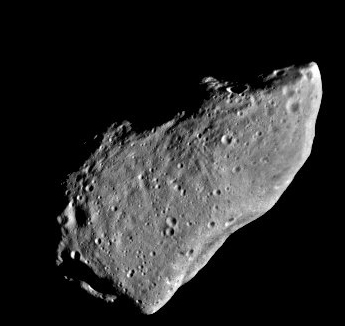An intensifying research focus on asteroids reveals two main points: There are a lot of them, and we don’t know a lot about them.
What can be said is that in the quest to learn more about asteroid shapes, Northern Arizona University is a world apart. In fact, NAU is the number one producer of newly calculated asteroid shapes on the planet.
“Although more than 700,000 asteroids are known to us as of today, we still know very little about these objects,” said Michael Mommert, postdoctoral scholar in the Department of Physics and Astronomy. “We mostly don’t know how big asteroids really are, what they are made of, how fast they spin, or what shapes they have.”
Such questions are important because an asteroid’s shape and rotation can tell scientists how strong the forces are that keep an asteroid in one piece. That sort of information is crucial when considering the possibility of, and reaction to, an asteroid that could impact Earth.
Through high-performance computing as part of a distributed network, NAU is contributing world-leading amounts of knowledge to the study of asteroid properties.
Finding shape and spin is cumbersome and requires multiple measurements of an asteroid’s brightness over a long period of time, Mommert said. Some data can come from large asteroid surveys such as Pan-STARRS, which uses two telescopes located in Hawaii to search for asteroids every night.
An international team of researchers led by Mommert and David Trilling, associate professor in Physics and Astronomy, use their access to the Pan-STARRS data, comprising roughly 10 million brightness measurements of 450,000 different asteroids—the largest available data set of this kind—to investigate asteroid properties. Their goal is to derive information on these asteroids, including constraints on their shapes and compositions, that will help the scientific community better understand the evolution of the solar system.
Dealing with large amounts of data requires a lot of computer time, and one powerful way to approach this problem is with the distributed computing project asteroids@home, which is led by Mommert and Trilling’s collaborator Josef Durech from Charles University Prague in the Czech Republic.
Distributed computing works by connecting many otherwise unused computers to attack a single scientific problem in an interconnected fashion, and frequently includes personal computers that are available at night, idle computer servers and other machines that non-scientists can sign up with. People all over the world use asteroids@home to derive the shapes of asteroids from available observations—including those from Pan-STARRS—using this world-wide grid of computers.
With the help of systems administrator Christopher Coffey, NAU’s high-performance computing cluster Monsoon has joined this effort with its immense computing power and made it straight to the top of the most efficient contributors to the asteroids@home project.
On average, Monsoon is able to derive one asteroid shape model per day—a process that takes weeks to months on a desktop computer. At NAU, asteroids@home runs only when Monsoon is idle and not working on other research projects from across campus.
“Through the use of Monsoon with this project, NAU is playing a leading role in solar system research,” said Mommert.



